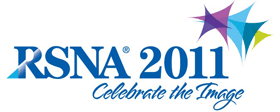
Abstract Archives of the RSNA, 2011
Samir Abboud BS, Presenter: Nothing to Disclose
Frederick Ethan Weiss MD, Abstract Co-Author: Nothing to Disclose
Cesar E. Orellana MD, Abstract Co-Author: Nothing to Disclose
Anna Orellana MD, Abstract Co-Author: Nothing to Disclose
Eliot L. Siegel MD, Abstract Co-Author: Research grant, General Electric Company
Speakers Bureau, Siemens AG
Board of Directors, Carestream Health, Inc
Research grant, XYBIX Systems, Inc
Research grant, Steelcase, Inc
Research grant, Anthro Corp
Research grant, RedRick Technologies Inc
Research grant, Evolved Technologies Corporation
Research grant, Barco nv
Research grant, Intel Corporation
Research grant, Dell Inc
Research grant, Herman Miller, Inc
Research grant, Virtual Radiology
Research grant, Anatomical Travelogue, Inc
Medical Advisory Board, Fovia, Inc
Medical Advisory Board, Vital Images
Medical Advisory Board, McKesson Corporation
Medical Advisory Board, Carestream Health, Inc
Medical Advisory Board, Bayer AG
Research, TeraRecon, Inc
Medical Advisory Board, Bracco Group
Researcher, Bracco Group
Medical Advisory Board, Merge Healthcare Incorporated
Medical Advisory Board, Microsoft Corporation
Researcher, Microsoft Corporation
Jean Jeudy MD, Abstract Co-Author: Nothing to Disclose
Mobile imaging offers great potential for untethering the radiologist from a diagnostic workstation, extending their impact on patient care beyond the reading room. This study assessed the role of an iPad as a imaging tool for gross pathology with regards to tuberculosis (TB) screening.
Chest x-rays were collected from 250 patients (200 negative and fifty positive) referred for TB screening, and identifying information was removed. All images were reviewed independently and in random order by five chest-fellowship trained radiologists on LCD PACS monitors, and scored as either positive or negative for TB. All images were also reviewed (in random order) by the same five readers on an iPad display using the OsiriX DICOM viewer. Each pair of readings (monitor and iPad for each reader) was separeted by one month, and the display method for the first reading was randomly selected to reduce bias. The iPad image review occurred in an office setting with more ambient light than the reading room. The results were tabulated and investigated for inter- and intra-reader variability using intraclass correlation statistics.
Preliminary results indicate no statistically significant difference in sensitivity and specificity for detection of TB between LCD PACS monitors and iPad display.
The iPad was not demonstrated to be inferior to a standard LCD workstation monitor for the purposes of TB screening. Because of the composition of the reader group, these results apply only to fellowship trained chest radiologists, and cannot be extended to radiologists earlier in training or other fields. In spite of this limitation, it is reasonable to conclude that the iPad warrants further investigation as a medical imaging and teaching tool.
The iPad holds great potential as an adjunct to an imaging report, potentially as a screening tool, and allowing for greater integration of the radiologist into the clinical care team.
Abboud, S,
Weiss, F,
Orellana, C,
Orellana, A,
Siegel, E,
Jeudy, J,
TB or Not TB? Inter- and Intrareader Variability in Screening Diagnosis on an iPad vs a Traditional Display. Radiological Society of North America 2011 Scientific Assembly and Annual Meeting, November 26 - December 2, 2011 ,Chicago IL.
http://archive.rsna.org/2011/11013548.html

